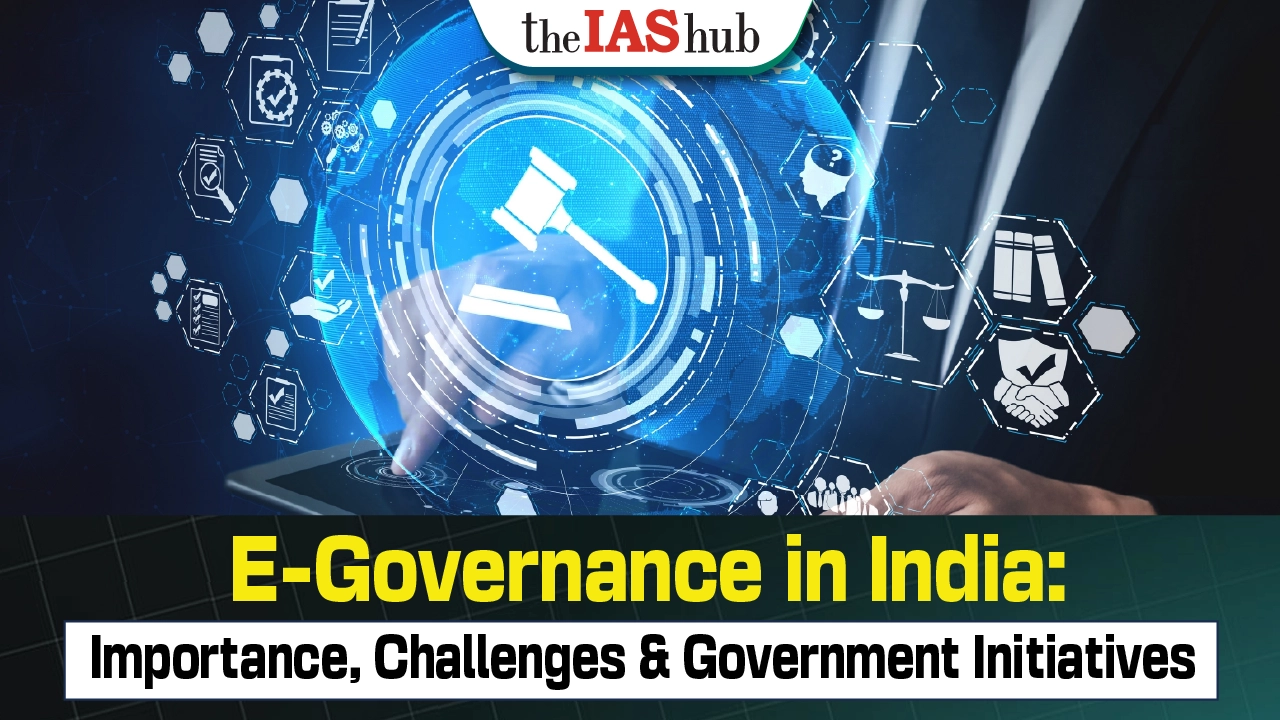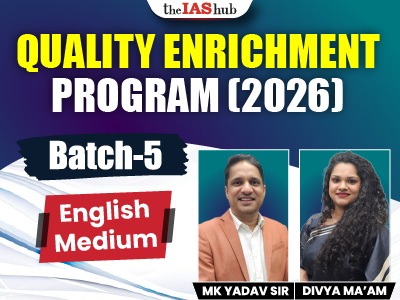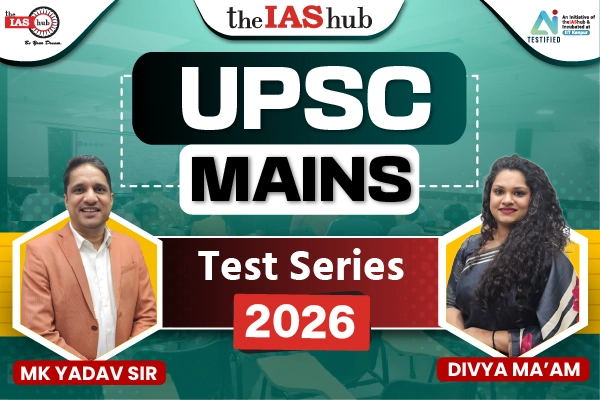E-Governance, according to the 2nd Administrative Reform Commission (ARC) Report, is primarily related to carrying out governance tasks and achieving governance outcomes through the use of what is today known as ICT (information and communication technology).
Need for E-Governance in India
- Effective adoption of E-Governance initiatives may result in less corruption, improved accountability, greater convenience, revenue gains, and/or cost savings.
- The goal of implementing e-governance is to improve performance and assure proper service delivery.
- This will be accomplished through the use of five "SMART" e-governance characteristics.
Factors Pushing India towards e-Governance

- Rising numbers of mobile phone users and data consumption: According to a Nokia report, average data consumption per user in India reached 19.5GB per user a month in 2022.
- Due to the rising availability and falling cost of high-speed broadband and smartphones, India likely to have 900 million active internet users by 2025.
- Success of Digital India mission and eKranti: To help millions connect online, the Digital India programme is providing broadband internet to 250,000 gram panchayats.
- Rising eCommerce and digital economy: India is poised for the next phase of growth, creating tremendous economic value and empowering citizens as new digital applications permeate sector after sector.
- India's digital economy might generate $1 trillion in 2025.
- JAM trinity: 1.21 billion Indians enlisted in the government's biometric digital identity initiative.
- Jan Dhan Yojana and other government initiatives have enabled banking, pension (PMSBY and PMJJBY), and insurance (Atal Pension Yojana) services for average folks, digitally empowering them.
Significance of E-Governance in India

- Improved service delivery: The new India has pioneered e-government, using ICT for elections, census, computerising government offices, digi lockers, e-transportation, e-health, e-education, and e-taxation.
- Through MC21 data, corporates and other stakeholders will have convenient and secure online access to all registry-related services provided by the Union Ministry of Corporate Affairs.
- Improve industry-business interaction: E-governance accelerates industrial growth processes.
- De-bureaucratization: E-governance narrows the distance between the people and the government in all services and reduces the people's dependence on the bureaucracy.
- Reducing corruption: E-governance tracked government activity online, eliminating corruption.
- Linking AADHAR with MGNREGA daily wage payments helped to eliminate bogus beneficiaries and reducing corruption.
- Hierarchy Elimination: ICT involved all levels in decision-making.
- Plug leakages: The e-governance ecosystem has helped the union government to plug about $27 billion in leakage by digitally transferring money via DBT.
- Automation in Administrative Processes: To eliminate the Great Indian Red Tape, Saharsa became Bihar's first paperless (e-office) district.
Challenges with E-Governance in India
- Trust deficit: Any entity may commit financial, value, or personal information fraud. Departmental data is sometimes overlooked in government offices.
- Digital divide: According to the India Inequality Report 2022: Digital Divide by Oxfam, the richest 60 per cent Indians are four times more likely to use digital payment facilities than the poorest 40 per cent.
- Adoption Cost: India spends 3% of GDP on the implementation of e-governance initiatives. The government should encourage officials, administrators, and citizens to use e-governance services by using public funds wisely.
- Privacy and Security and infrastructure related issues.
- Hackers released all CoWIN data on Telegram.
- Screenshots of the data contained names, mobile numbers, Aadhaar card details, PAN card credentials, date of birth, and vaccination centre information. Some passport details were leaked.
Barriers in adoption of e-Governance in India

- Accessibility: According to the India Inequality Report 2022: Digital Divide by Oxfam, access to the internet through any kind of device was found to be far better in urban India at 44 percent than in rural areas at 17 percent.
- Usability: Only 38 percent of households in the country are digitally literate.
- Use of local languages: Between mother tongue, second and third language, the 2011 census records that over 10% of Indians reported being able to speak some English.
- To improve e-services, the government should translate this language into regional languages.
- E-governance awareness: Due to illiteracy, rural internet access, lack of intent to use internet services, etc., many people in the country are unaware of it.
- Thus, informed citizens, concerned institutions, and departments should help rural populations use e-services.
- For this government came with the national e-governance policy (NeGP).
- E-governance operations and service upkeep cost the government a lot.
- Government models must be reusable. E-governance is a nationwide plan with software and modules for other administrations.
- Maintainability: Because the IT ministry develops new software to meet citizen wants. Thus, government introduced new schemes like digital India.
- Portability: For administration reuse, portable applications must be independent of hardware and software platforms.
- E-governance interoperability: Ministry-department cooperation hampers data processing and exchange.
- E-governance challenges include web-based data collection and format.
- Security: E-governance services like insurance, banking, and utility bill payments have security concerns.
- Cases related to online frauds have come down by about 17.5 per cent in 2022 to ?128 crore. But the number is still very high.
- Privacy: Government should protect citizen data.
Steps Needed to Strengthen the e-Governance Architecture of India

- Greater Digital Infrastructure and Connectivity.
- Improve government-citizen dialogue.
- Services on Demand: With a bottom-up approach to planning using separate urban-rural socio-economic databases, government ministries must identify, evaluate, formulate, implement, and correct data-driven policies to meet population needs as soon as possible.
- Focus on Local E-governance: local governments are closest to residents and serve as many people's main point of contact with government.
- Deployment of Intermediaries: E-Governance is designed to maximise citizen happiness by increasing public service delivery and citizen participation in governance procedures.
- India's multilingual population benefits from e-government in regional languages.
- Understanding E-readiness: India's states are at varying levels of e-readiness, therefore e-Governance reforms must take this into account.
Models of E-Governance in India

- Broadcasting Model: The model is based on dissemination; broadcasting of useful Governance information and it will also provide people with correct information.
- Critical Flow Model: The model is based on disseminating, channeling information of critical value to the targeted audience or into the wider public domain.
- Comparative Analysis Model: The model continuously assimilates best practices in the area of governance and use them as bench mark to evaluates other governance practices.
- The e-advocacy Model: This model helps the global civil society to impact on global decision-making process.
- The Interactive Service Model: the various services offered by the government and it became directly available to its citizen in an interactive manner.
- Example: CoWin app, Digilocker and UPI.
Important e-governance Models given by the 2nd ARC
|
Model
|
Examples
|
|
Government to government (G2G)
|
- The Karnataka government's Khajane Project computerises its treasury online.
- SmartGov (Andhra Pradesh): SmartGov streamlines processes and improves efficiency through workflow automation and knowledge management for the Andhra Pradesh Secretariat.
|
|
Government to citizens (G2C)
|
- Digilocker, CoWin App, UPI etc.,
- Rajasthan’s e-Mitra: Rajasthan Government provides citizen services quickly and conveniently.
- Gyandoot: Madhya Pradesh government project. The Mission Mode Project designated 2,50,000 panchayatiraj institutions to provide rural e-government services.
|
|
Government to Business (G2B)
|
- MCA 21 database: by Corporate Affairs Ministry.
|
|
Government to employee (G2E)
|
- iGoT platform for employees to train them and equip them to handle emerging challenges in governance.
|
Recent Government Initiatives to Promote E-Governance in India
- MyGov Initiative: It has been established as Government of India’s Citizen Engagement Platform which collaborates with multiple Government bodies/Ministries to engage with citizens for policy formulation and seeks the opinion of people on issues of public interest and welfare.
- National e-Governance Plan: It is an initiative of the Government of India to make all government services available to the citizens of India via electronic media.
- National Center of Geo-informatics: It is a Geographic Information System (GIS) based decision support system platform, under National e-Governance Division (NeGD) of Ministry of Electronics and Information Technology (MeitY).
- Darpan Portal: It is an initiative started by the National Informatics Centre and NITI Aayog. It facilitates an interchange of information between NGOs, Voluntary Organisations (VOs) and government departments, ministries and bodies.
Conclusion
E-Governance has improved citizen access to information and services, government efficiency, accountability, and reach. The research recognises that e-Governance projects must be built for specific settings and environments due to India's diverse conditions and vast range of e-Governance initiatives with various degrees of success.
















